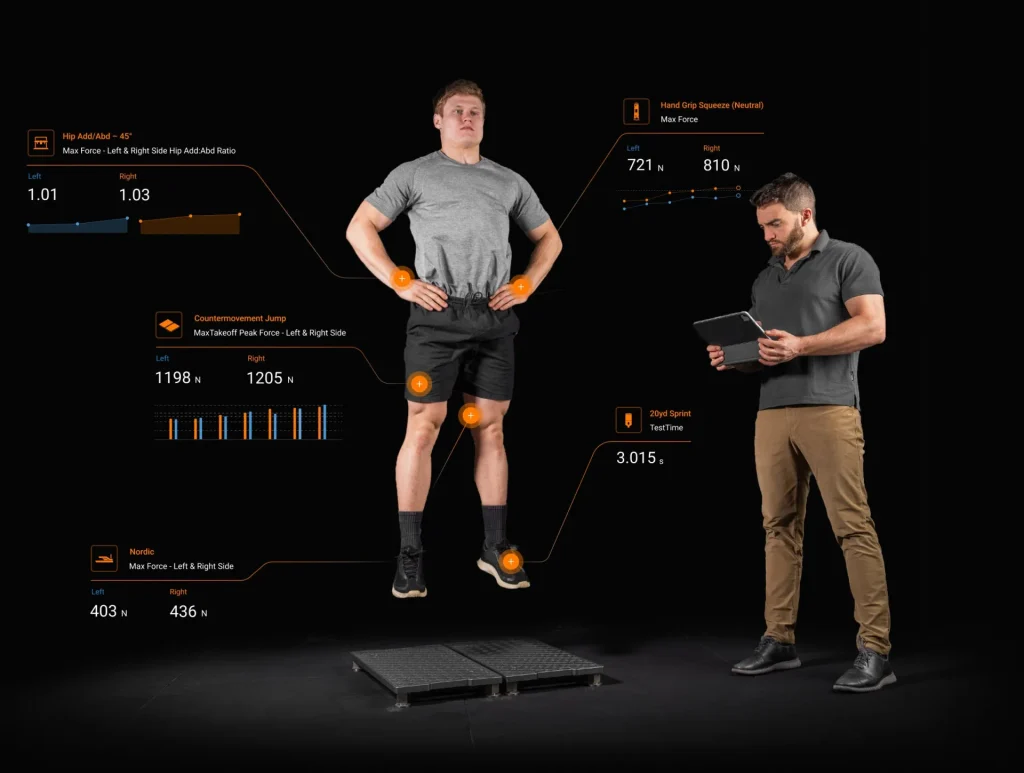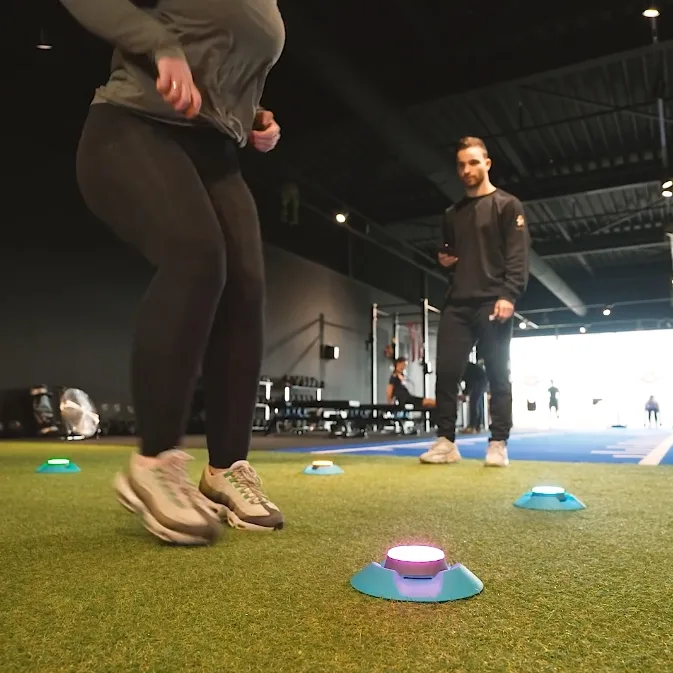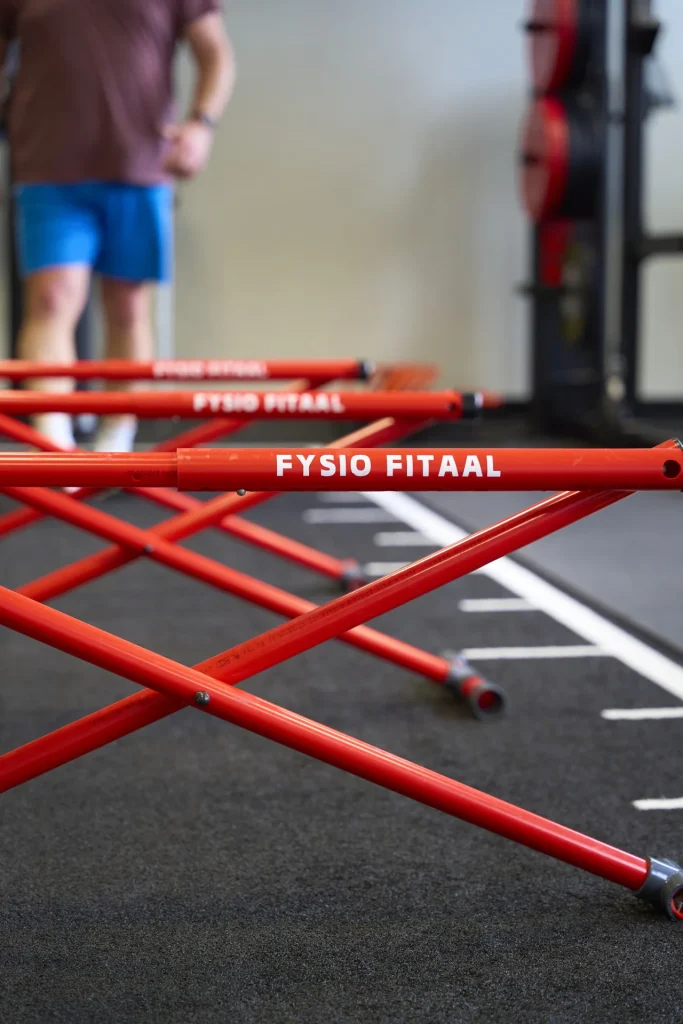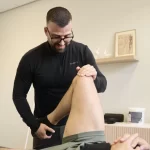VKB rehabilitation: why muscle strength alone is not enough
Recovering from anterior cruciate ligament surgery (VKB reconstruction) is intensive. Many athletes rightly focus on building muscle strength. But strength alone is not enough to safely return to sport. If you want to sprint explosively, land solidly and change direction quickly, you also need to work on your reactive power, elasticity and neuromuscular control.
At Fysio Fitaal, we regularly see athletes who still have complaints months after their rehabilitation or do not experience confidence on the field. Underlying factors are often crucial building blocks missing in the recovery process. With the right tests and training, we make that clear and measurable.

Muscle strength as a foundation: LSI and strength testing with Technogym
At Physio Fitaal, we start with a solid foundation: muscle power. For this, we use the Technogym strength equipment, including the Leg Extension, Leg Curl and Leg Press. With these, we test strength in a controlled setting, often at 80% of the level measured in reference tests (such as the Biodex) or based on body weight.
We measure bilaterally and calculate the Limb Symmetry Index (LSI): the ratio of the operated to the non-operated leg. An LSI of 90% or higher is often used as a lower limit for return-to-sport (van Melick et al., 2016). However, this test mainly measures maximum strength in controlled conditions. Sport is all about speed, braking, explosiveness - and that requires more than strength.
What is RSI - and why does it count?
The Reactive Strength Index (RSI) is a measure of how quickly and forcefully you can react in a stretch-shortening cycle (such as landing and direct off). At Fysio Fitaal, we measure RSI using VALD ForceDecks: advanced force plates that precisely record jump height, contact time, asymmetry and force build-up.
We do this including via a drop jump: you step off a platform, land, and jump straight up. The ratio of contact time to jump height gives the RSI. The higher your RSI, the better your explosive power. And the lower, the more likely your body is to respond inadequately fast and controlled during dynamic sporting moments (Edwards et al., 2022).

Elasticity and explosive loading
Elasticity in sport means: storing and releasing force quickly - like a spring. Think sprints, push-offs, sudden deceleration or a fast jumping movement. Many athletes after VKB reconstruction lack this ability, despite a good score on strength tests.
That's why we train focused on:
- Plyometrics (drop jumps, rebound jumps, single-leg hops)
- Horizontal and vertical elasticity
- Change of direction drills with variable inputs
The VALD plates allow us to objectively determine whether your braking power, push-off force and symmetry meet sport-specific requirements.

Neuromuscular control: reflexes, balance and change of direction
After VKB surgery, the nervous system is partially "dysregulated". Sensory input from the knee is reduced, and this affects your reflexes, balance and timing. As a result, errors are more likely to occur in complex, fast sports movements.
At Physio Fitaal, this is why we train:
- Balance under time pressure
- Reactive coordination (visual and auditory)
- Directional changes with unexpected stimuli
- Hull stability in rotation and eccentric control
Grooms et al (2017) describe how motor networks in the brain need to reorganise after a VKB rupture. Training must be tailored accordingly - only then will you truly recover functionally.

What we measure and train at Physio Fitaal
Our approach combines multiple measurement tools and tests to fully assess your recovery:
- Force measurements (Leg Press, Leg Curl, Leg Extension)
- VALD ForceDecks for RSI, jump analysis, asymmetry and load curves
- Agility and acceleration/deceleration testing
- Return-to-sport tests, such as:
- Single-leg hop for distance
- Triple hops
- Crossover hop
- T-test / Illinois Agility
- Single-leg hop for distance
Thus, we bring not only your strength, but also your responsiveness, control and resilience in pictures.

Are you already further along in your journey? Schedule a test
Are you 6 or 12 months postoperatively but still in doubt about your sporting level? Or have you regained symptoms during loading? Then schedule a separate test moment at Fysio Fitaal.
You will receive a comprehensive assessment of your strength, RSI and functional load capacity, with clear advice on next steps. Athletes without recent VKB surgery, but with long-term knee problems, can also benefit from such a check-up.
Sources
- van Melick, N., et al. (2016). How to determine return to sport after ACL injury: A systematic review. British Journal of Sports Medicine.
- Edwards, S., et al. (2022). Reactive strength and deceleration ability in athletes. Journal of Sports Sciences.
- Grooms, D. R., et al. (2017). Neuroplasticity following ACL injury: A framework for visual-motor training. JOSPT.

Related complaints

Anterior cruciate ligament injury
Are you suffering from an anterior cruciate ligament injury or want more information? Feel free to...

Cyclops (arthrofibrosis)
Cyclops also known as arthrofibrosis is caused by scar tissue in the knee often after...

Meniscus injury
A meniscus injury is one of the most common knee problems in Physiotherapy

Medial band knee(MCL)
An injury to the inner ligament of the knee requires accurate diagnosis and a...

Knee complaints
Especially with knee problems, it is imperative to get a good picture of the...
